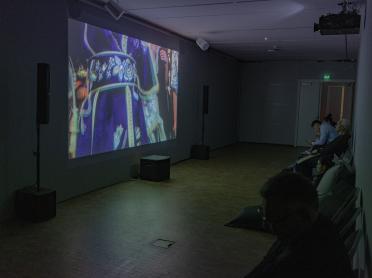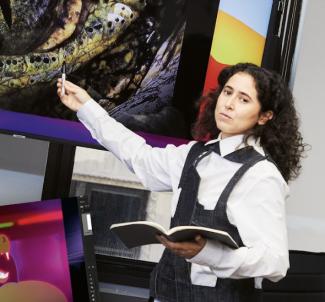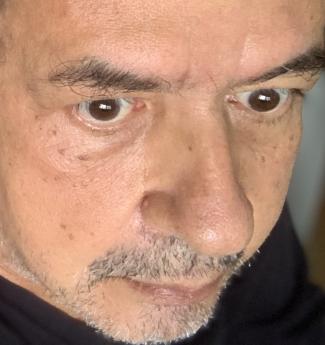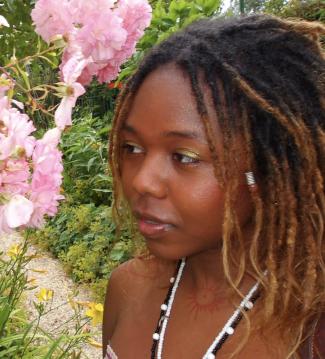Film cycle
Friday 20 Sep 2024 from 6pm to 9:30pm
Saturday 21 Sep 2024 from 11am to 9:30pm
Sunday 22 Sep 2024 from 11am to 6:30pm
Free entry
Screening on the 3rd floor

A series of films, on a loop, to be discovered freely throughout the Échelle Humaine festival.
Part travel documentary, part soap opera, part gossip session, FLY immerses viewers in an environment of brightly coloured geometric shapes and surfaces. An animated fly serves as a guide, buzzing mischievously around an open-air market, weaving its way through the medina districts of Rabat and Fez, and taking viewers beyond the walls of private homes or into sumptuous receptions. FLY tests the limits of what we consider familiar or strange, real or virtual.
→ The Jump (Part 1), by Hetain Patel, video, 5min40
As in the movies, Spiderman's body unfurls and flies. Here, however, his leap is deprived of context and slowed to a crawl. Neither the familiar costume nor the emphatic music give any clue to his motivation, which seems to lie solely in the movement itself. From one point to the other of this suspended journey, the communicative momentum reflects the strength of our desires, as much as our need for models.
→ Me faça um pedido, by Castiel Vitorino Brasileiro, 2021, video recording, 6min
Calm is the enemy of perfection. And only fear is perfect.
→ Corbeaux, by Bouchra Ouizguen, 2017, video, 7min37
Corbeaux was filmed one morning in May 2017 in the Marrakech region. Performed by dancers from choreographer Bouchra Ouizguen's Compagnie O, Corbeaux is inspired by questions of Ritual and Nature. Memories of trance come to the surface, bringing out the raucous sound and smell of the earth.
→ By eath, sea and air we came, by Adham Faramawy, 2021, video, 18min
By earth, sea, and air we came interweaves the lives of flowers, parakeets and sailors around a river flowing on the outskirts of a city. The film draws on history, biology, geography and mythology to reflect experiences of migration and to the relationship that the artist, as a migrant and a person of colour, has with ideas of land and place.
→ OMUNDO DE JANIELE, by Caetano Dias, 2007, video, colour, 4min05
On a sunny afternoon, a little girl is hula hooping in a favela, while the world spins around her. The little girl with the fiery hair is like the centre of her own universe, like the solar element of an orbit drawn by the hula hoop and reiterated by the circular movement traced by the camera. The continuous rhythm of the hoop, reflecting her inner state, seems to be the thread of life that she is trying to keep in motion.
Meriem Bennani has been developing a shape-shifting practice of films, sculptures and immersive installations, composed with a subtle agility to question our contemporary society and its fractured identities, gender issues and ubiquitous dominance of digital technologies.
Bennani’s work has been shown at the Whitney Biennale, MoMA PS1, Art Dubai, The Vuitton Foundation in Paris, Public Art Fund, CLEARING and The Kitchen in New York.
Her animated series, 2 Lizards, a collaboration with director Orian Barki, premiered on Instagram during Spring 2020 and was described by The New York Times as “hypnotic…deploying a blend of documentary structure and animation surrealism…both poignantly grounded in actual events and also soothingly fantastical” and its animated protagonists “art stars.” (Jon Caramanica, April 2020).
Adham has had screenings and performances at the Guggenheim Museum, New York; Tate Modern and Tate Britain, London; Serpentine Gallery, London and Serpentine Ecologies Symposia, London.
Adham Faramawy have had recent exhibitions at Goldsmiths Centre for Contemporary Arts, London (group), Somerset House, London (group), Buffalo University Gallery, Buffalo (group); the Bemis Center, Omaha (group); Niru Ratnam Gallery, London (solo), Chapter, Cardiff (solo) and Cell Projects, London (solo).
They were shortlisted for the Film London Jarman Award 2021 and 2017 and was the recipient of the Frieze London Artist Award 2023.
His work does not favour any specific medium or technique. He works with video, painting, three-dimensional works, multimedia installations and digital photography.
He has had numerous solo exhibitions at the MAM/BA in Salvador (1995); the Paulo Darzé art gallery, Salvador (1999 and 2010); the Casa de Las Américas, Havana, Cuba (2001); the Temporada de Projetos at the Paço das Artes in São Paulo (2002); the ICBA - Instituto Cultural Brasil-Alemanha, Salvador (2001); Paço das Artes, São Paulo; Marília Razuk Galeria de Arte, São Paulo; MAM/BA, Salvador (2002); MAM/RJ, Rio de Janeiro (2003); Paço das Artes, São Paulo (2004); MAC/CE, Fortaleza (2010); Centre Cultural Yves Alves, Tiradentes (2013), among others.
He has participated in numerous group exhibitions, including ‘The Brazilian Northeast Contemporary Art’ at Liberty St. Gallery, New York and the third MAM-Bahia show at MAM/BA, Salvador. Gallery, New York and the third MAM-Bahia show at MAM/BA, Salvador (1996); ‘Metacorpos’ at Paço das Artes, São Paulo (2003); ‘Baroque Strategies: Brazilian Contemporary Art’ at the Metropolitan Cultural Centre, Quito, Ecuador (2004); “The Body in Brazilian Contemporary Art” at Itaú Cultural, São Paulo (2005); “Por um fio” at Paço das Artes, São Paulo and “Art Supernova” at Art Basel Miami, USA (2007); ‘Interconnect - Between Attention and Immersion’ at the ZKM Centre for Art and Media, Bradenburg, Germany (2006); “Por um fio” at Paço das Artes in São Paulo and “Art Supernova” at Art Basel Miami in Miami, USA; ‘Paisagens Oblíquas’ at the Berardo Foundation in Lisbon, Portugal and the exhibition “Continents à La derive” at the CRAC Languedoc-Roussilon in Sète, France (2009); “Tékhne” at the MAB/FAAP in São Paulo and “Ponto de Equilibrio” at the Tomie Ohtake Institute, São Paulo (2010); ‘Da solidão do lugar a um horizonte de fugas’ at the Berardo Collection Museum, Lisbon, Portugal (2012); “Do Valongo à Favela - Imaginário e periferia” at the Rio Art Museum,Rio de Janeiro and “Frestas - I Trienal de artes Visuais” at the SESC in Sorocaba, SP (2014); “Porque Somos Elas e Eles” at Galeria Blau Projects, São Paulo (2016); ’Axé Bahia :
‘Da solidão do lugar a um horizonte de fugas’ at the Berardo Collection Museum, Lisbon, Portugal (2012); “Do Valongo à Favela - Imaginário e periferia” at the Rio Art Museum, Rio de Janeiro and “Frestas - I Trienal de artes Visuais” at the SESC in Sorocaba, SP (2014); “Porque Somos Elas e Eles” at Galeria Blau Projects, São Paulo (2016); “Axé Bahia : The Power of Art in an Afro-Brazilian Metropolis” at the Fowler Museum, Los Angeles, USA and “Negros Indícios” at Caixa Cultural São Paulo (2017).
He has also taken part in a number of art fairs, including the International Art Fair in Miami, Florida; the first Buenos Aires International Art Biennial at the Museo Nacional de Bellas Artes in Argentina; the 3rd Mercosur Visual Arts Biennial in Porto Alegre, RS; the 8th Bahia Fair, at the MAM/BA, Salvador; the 5th Barro de América Biennial, Maracaibo, Venezuela; the 29th Panorama of Brazilian Art, at the MAM/SP, São Paulo; the 4th Valencia Biennial in Spain and the 16th Cerveira Art Biennial, in Vila Nova de Cerveira, Portugal.
In 2000, Caetano Dias was awarded the FICC/BA - ABCV prize at the 7th Bahia Salon at the MAM/BA in Salvador for his feature film ‘Rabeca’. In 2007, in France, he was awarded the Le Fresnoy prize for audiovisual creation as part of the Videobrasil residency programme for his film ‘Canto Doce Pequeno Labirinto’.
In his multidisciplinary practice, Castiel Vitorino Brasileiro investigates the mystery between life and death and the ways of navigating between these existential zones.
His work has been shown in numerous institutions, including the 35th São Paulo Biennial (Brazil, 2023), Serpentine (UK, 2023), the Visual Arts Center at the University of Texas (USA, 2022), Kunsthalle Wien (Austria, 2021) and the 11th Berlin Biennale for Contemporary Art (Germany, 2020).



